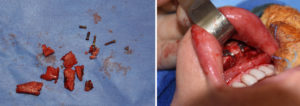The use of implants for chin augmentation is the most popular method to achieve enhanced projection of the lower face. Many materials have been used for chin implants and today it usually comes down to the use of either a silicone or Medpor material. There are surgical advocates for both types of chin implants and both can be successfully used under the right circumstances.
Where silicone and Medpor chin implants differ dramatically and unequivocally is if the patient wants the implant removed. The aggressive tissue ingrowth into the Medpor material makes its removal difficult and fairly traumatic to the surrounding tissues. I have read some surgeons who say the material can’t be removed. This is not true, it is just that it is much more difficult than the easy removal of silicone implants.
If a Medpor chin implant is removed, there is often the need to replace it. The question is what should that be. That depends on why the implant was originally placed, its size and shape, and what the patient’s aesthetic goals.

While chin implants are made of different materials, their effectiveness is best determined by the selection of implant style and size. It is important that chin augmentation in females is seen as aesthetically different than that of men. The type of chin implant style that works well in men often does not in females.
Dr. Barry Eppley
Indianapolis, Indiana


